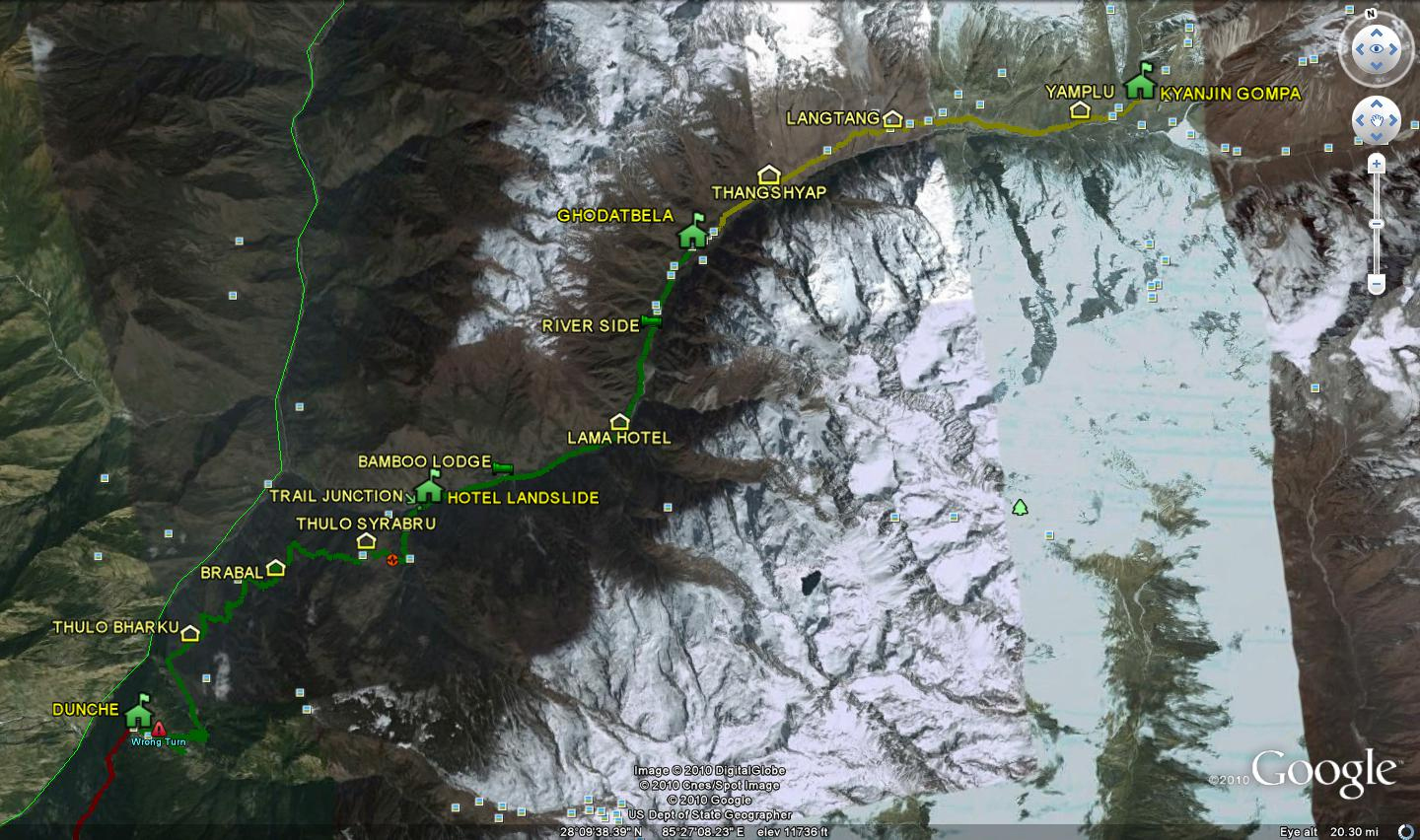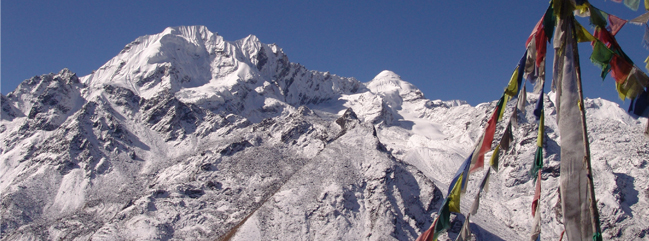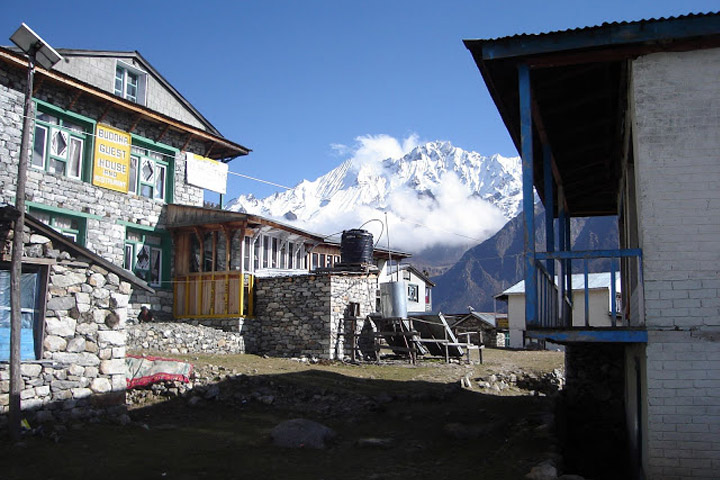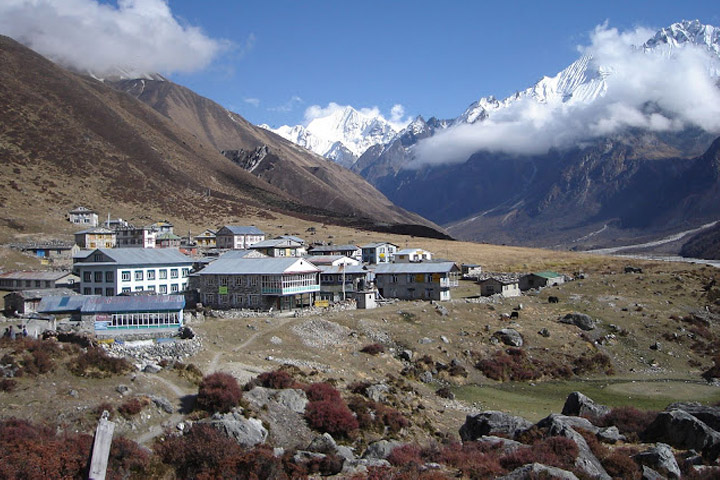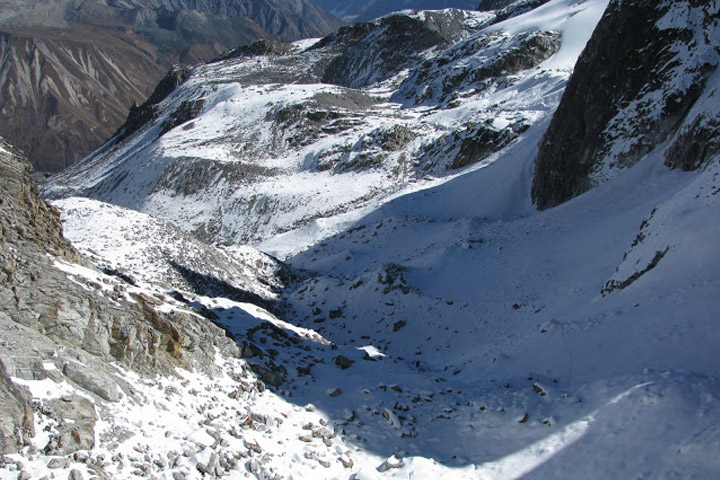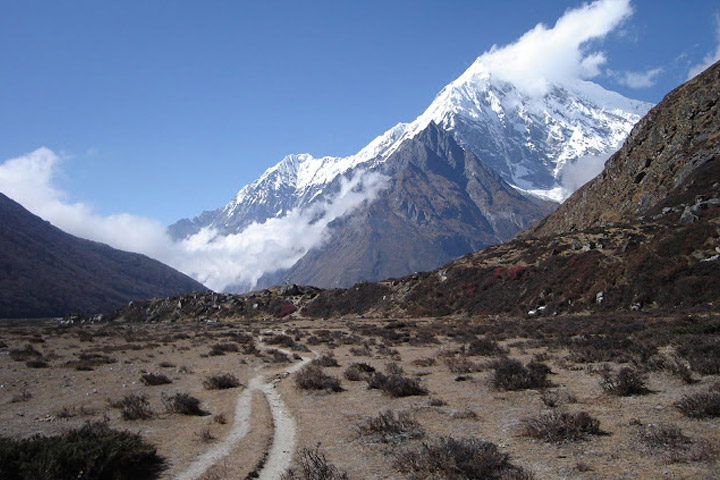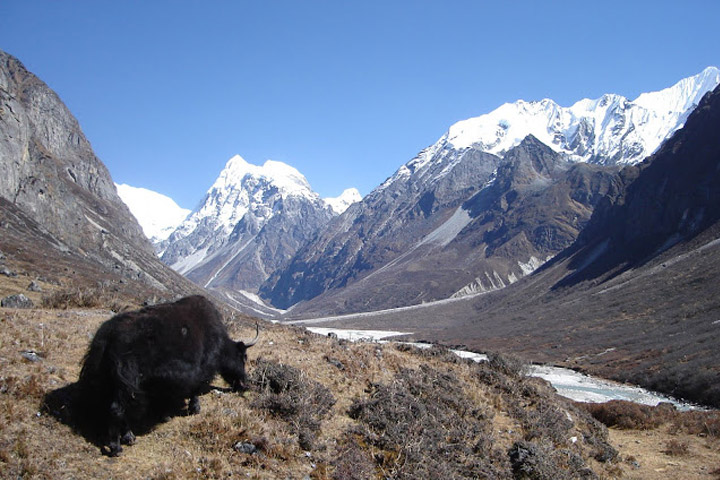Trekking in Langtang valley and Ganja La which is located north of Kathmandu offers a multitude of trekking destinations. Langtang is a narrow valley that lies just below the main Himalayan range to the north Tibet Border and a slightly lower range of snowy peaks to the south. A visit to the Langtang valley offers an opportunity to explore Tibetan villages, Tamang Villages, to climb small peaks and to visit glaciers at a comfortably low elevations. Kyanjin Gompa is a last Tibetan Village in the valley, from where a trek starts to Helambu over Ganja La Pass (5200M). The pass it self is not easy, during autumn and spring the pass opens for trekkers.
A trek Over Ganja la pass offers an entirely wilderness and adventure experience. If you are trekking during spring the forest on the trail is colorful and blooming full of Rhododendrons. To cross from Langtang into Helambu via the Ganja-La pass which is a serious undertaking requiring good equipment and experience from local guides. For three or four days there are no facilities and groups with their staff must be fully self-sufficient. Crossing of the pass requires the use of technical climbing equipment and trekkers must be skilled in the use of this and be prepared to assist less well-equipped porter staff. The trail follows a small valley before reaching the glaciated pass where the use of ropes, crampons and ice axes may be necessary.
Day 01- Arrival in Kathmandu airport (1345meters).
There you will be met by our Airport Representative and transferred to hotel by private tourist vehicle. Overnight at hotel.
Day 02- Sightseeing around Kathmandu valley.
Your sightseeing trip will start at 9 AM in the morning after breakfast. We provide a private vehicle and professional tour guide. Places we visit are Pasupatinath temple, Buddhanath, Monkey temple, Bhaktpur durbar square and Kathmandu durbar square. The afternoon includes a final briefing and preparations for the trek. Overnight at hotel.
Day 03- Drive to Sybru Bensi (1462meters) by bus 8 hours.
Drive from Kathmandu to Syabru Besi which takes about nine hours by bus or Land cruiser depending on group size. You head north out of Kathmandu driving through scenic foothills and ridgeline vistas to Syabru Besi passing through Dhunche. While passing along the road at the bank of Trishuli river you catch a glimpse of Ganesh Himal, terraces and green hills. As you pass through Dhunche you feel as if you are heading towards deep land. At the same time, you notice that the road is still under construction. Overnight at tented camp.
Day 04- Trek to Lama Hotel (2500meters) 5 hours.
Today, the first part of the trail crosses through Bhote Koshi and follows the Langtang Khola. This trail gradually ascents up to Bamboo passing through the Landslide. Afterwards, your trek ascends gently to Rimche (2400meters) through Bamboo (1960meters) which lies at the bank of Langtang Khola. You can have lunch at this place if you like at the end your trail is level to Lama Hotel. En route you could see red pandas, monkeys and bears if your lucky. Overnight at tented camp.
Day 05- Trek to Langtang Village (3307meters) 5 hours.
The trek route follows Gumanechok, Ghoda Tabela literally it means the Horse Stable. After the trail is slightly gradual providing beautiful valley views with the grazing Yaks. Langtang village is very local and old along this trekking route. The view from here is more spectacular as we are getting closer to the mountains. Overnight at tented camp.
Day 06- Trek to Kyanjin Gompa (3798meters) 4 hours.
Today is a shorter walk but enough for acclimatization. The surroundings are interesting because of the famous Cheese factory. This is the beautiful valley in the lap of the Langtang Lirung and other around. This is the place to explore the valley and lots of small peaks to climb. Overnight at tented camp.
Day 07- Kyanjin Gompa exploration day.
Today is a day to rest and explore the area. You can visit the monastery and cheese factory, walk up the moraine to see the spectacular ice faces and tumbling glaciers of Langtang Lirung or ascend Kyangjin Ri (4350meters) which is highest point of this trek, directly behind the village, for a breath-taking panorama of the Langtang peaks. Overnight at tented camp.
Day 08- Trek to Ngegang (4000meters) 5 hours.
Here you can not see any villages. The trail goes on ascending and the area is covered with few natural vegetation. Since there are no lodges available. Overnight at tented camp.
Day 09- Trek to Keldang (4300meters) via Ganja La (5200meters) 6 hours.
Today is comparatively strenuous as you need to cross the Ganja la pass over 5200 meters. On the Ganja la pass, you can find it covered with snowy ice most of the times through out the year. Overnight at tented camp.
Day 10- Trek to Dukpu (4080meters) 6.30 hours.
A long day walking along the ridge, grassland, with amazing views of Mountains. Your camping site will be inside the forest. Overnight at tented camp.
Day 11- Trek to Tarkeghyang (2560meters) 5.30 hours.
Trail descends about 200mtrs, climb the 4100meters pass. Views from Pass are spectacular towards the Annapurna Region and Mt. Everest region as well. From the pass the trail descends through pine forest, rhododendron forest past tiny herder’s to the settlement of Tarkeghyang. You can visit one of the oldest Buddhist monastery and Sherpa villages. These villages are well settled where friendly and cheerful natured people inhabit. Overnight at tented camp.
Day 12- Trek to Shermathang (2621meters) 5.30 hours.
This day the trail is quite easy through flat land with beautiful forests along the way. You trek on crossing some small streams. A beautiful village half way to Shermathang. Shermathang is another pretty Sherpa village where you can visit many ancient monasteries and also see Jugal Himal range at the north face of Shermathang village. Overnight at tented camp.
Day 13- Trek to Melamchi Pul Bazaar (846meters). 5 hours.
The trail gradually descends all the way to Melamchi Pul Bazaar through meadows and cultivated fields. Along the way, you come across several old villages with their own particular traditions. Walking today is quite pleasant with mountain views and interacting with friendly local people. Overnight at tented camp.
Day 14- Drive from Melamchi Pul Bazaar to Kathmandu. 4 hours.
After breakfast you travel along a bumpy gravel path up to Lamidanda and then follow the pitched road up to Kathmandu. Overnight at hotel.
Day 15- Leisure day in Kathmandu.
Extra day in Kathmandu for relaxing and some shopping , if you are interested in continuing onto Chitwan Jungle Safari, River Rafting Adventure, Kathmandu Shopping Tour or Scenic Everest Flight.
Day 16- Transfer for your final flight departure.
The trip ends, our Airport Representative will drop you to the Kathmandu International Airport for your flight departure from Nepal.
NOTE: The above information is a guide and standard template of what we provide. The trek can be customized at your request to accommodate your specific requirements.
Note : On adventure trips of this type, weather, local politics, transport or a multitude of other factors beyond our control can result in a change of itinerary. It is, however, very unlikely that the itinerary would be substantially altered; if alterations are necessary the leader will decide what is the best alternative, taking into consideration the best interests of the whole group. Where a change does occur, we do everything we can to minimize its effect, but we cannot be responsible for the results of changes or delays.
Q.What type of shape do I need to be in, is this trip for me?
A. Trekking is suitable for average people who are moderately fit, thus no previous experience is required. Some physical fitness programs such as running, swimming, hiking is recommended before you embark on your journey. Persons suffering from a pre-existing medical condition or disease must seek medical advice before considering the trek. Whilst on the trek, it is common to experience some discomfort before being fully acclimatized.
To prepare for a strenuous trek you should begin training at least two to three months before your departure. As a guideline, an hour of aerobic exercise three to four times per week would be considered a minimum requirement. The best preparation is bushwalking involving relatively steep ascents and descents. If you can manage a couple of valley floor to ridgeline ascents per comfortable and able to enjoy the trek to the fullest. They are physically strong, sharp-witted and have an incredibly positive attitude towards a life that we would consider extremely tough. There is something about a trek in the Himalaya that draws you back time and time again. For keen walkers it is a paradise and even avowed non-walkers find that one foot just seems to follow the other, drawn by the appeal of what lies beyond.
Q. Will somebody come to pick me up at the Airport upon my arrival?
A. Yes, our Airport Representative will be there to greet you outside of Terminal Hall, he/she will be displaying an Kiwi Adventures Treks & Expedition sign board. Upon arrival, you will be transferred to your hotel.
Q. What sort of accommodation can I expect in Kathmandu and in trekking?
A. 11 night’s Trekking Guesthouse, 4 nights three/four star hotels in Kathmandu.
We use standard rooms from three/four star hotels in Kathmandu with breakfast included. Along the trekking routes teahouses/Lodges generally provide basic clean facilities with a mattress and a quilt or blanket. We can also offer you sleeping bags if needed (which need to return after the trip) but it is a good idea to always have your own sleeping equipment. We usually provide single and double rooms as well as the occasional dormitory. The dining room is downstairs around a fire. All food will be cooked to order in the little kitchen. You should not enter the kitchen unless asked to do so.
Q. What sort of food can I expect in trekking?
A. In trekking most teahouses (lodges) cook a delicious range of mostly vegetarian fare. Pasta, tuna bakes, noodles, potatoes, eggs, dhal bhat, bread, soups, fresh vegetables (variety depends on the season) and even some desserts like apple pies, pancakes, and some interesting attempts at custard. You will find a lot of garlic on the menu because it assists with acclimatization – eat some every day. In many larger villages you may find some meat on the menu. You can always get hot chocolate, tea, and hot lemon drinks, as well as soft drinks, and treats like chocolate and crisps.
Each day dinner and breakfast are used to take in the same lodge you spend the night. Lunch will be taken on the way to destination.
Q. What sort of transportation you use?
A. Kiwi Adventures Treks & Expedition is all about providing you with local insights as well as adventure, with that in mind, where we think you will get more out of your holiday by using different means of transport that is what we do. Using a variety of private transport is an integral part of our Himalaya tours and enhances the experience!
We use private tourist vehicles for sightseeing, city tours and pickups. Depending on the group size we use cars, minibus, van or land cruiser. These small light vehicles are more manoeuvrable and flexible enabling us to take you through the Narrow roads of Nepal. All the vehicles are usually air-conditioned unless we are travelling in cooler areas.
Q. What is the best season for this trekking?
A. Our trekking season extends from mid- September to May. From early September the monsoonal rains decrease. By end of September through to December the weather is usually stable with mild to warm days, cold nights. February, March, April, May, October, November, December are the best time to do trek.
Q. What is the weather & temperature like in trekking?
A. Weather in the mountains is notoriously difficult to predict. At night it is generally cooler the days are generally warm. Winter (January and February) will be bit colder but the days can be quite beautiful and warm if the sun is out. There will be bit of snow during the month of January, February and December. It is also important to make sure that you can stay warm and dry in just about any conditions. Expect the unexpected! The temperature could be as high as 20 deg C to -15 deg C low.
Q. Can I charge my digital camera or other batteries on my trip?
A. These facilities will be available in most of the places in your hotel reception by paying some service charges. Remember to bring your adapters!
Q. Is there any communication while we are on trekking?
A. There are telephones in some villages along the trekking routes from which you can make international calls.
Q. Can I use credit cards in the places visit in trekking?
A. In most cities yes, to some extent, however once you leave those cities behind, all you need is cash.
Q. How much additional money do I need per day?
A. In Kathmandu, you can allocate US$ 10 – 25 for a lunch / dinner. It’s all depends on your spending habits. US$7 to 10 US$ a day will be enough to buy bottles of water, chocolates and few drinks in trekking.
Q. Do I need to tip my guide and porters? How much would that be?
A. This is a difficult thing to gauge. We have seen everything from 20USD to 1000 USD per person for guides and porters. Tipping is not required, but a small way to show your guides and local porters thanks for their help. The level of the tip should reflect the level of personal involvement with your guide.
Q. Is the water OK to drink? Do I need to bring purifying tablets/filter?
A. In most places bottled water is readily available. If you wish to drink normal water, you need to use purifying aid, which you will need to bring with you.
Q. Are the Kiwi Adventures Treks & Expedition staff insured?
A. Our company insures all our trekking staff, including guide, cook, sherpa and porters.
Q. What essential documents do I need to bring with me on tour?
A. *Valid Passport – must be valid for up to 6 months after you return from your tour, keep a separate photocopy.
*Travel insurance, keep a separate photocopy
*Cash and Traveller’s Cheques, keep numbers and proof of purchase separate
*Flight tickets
*Emergency contact numbers for T/C’s, banks, insurance, family contacts.
Q. Can I add extra days to my trekking trip?
A. A hoilday should never be about making it to the final point quickly. Along your trek we can add days at your request with additional costs to cover guides, porters, accommodation and food.
Q. Do you use yaks/porters on the trek or do we carry all of our own gear?
A. Whilst on the trek, our porter will take care of your luggage. All you need to carry is your small day bag for your personal belongings like camera, water bottle, sun cream etc only.
Q. What opportunities will I have for shower along the trek?
A. In major places, we arrange guesthouse with hot shower. And in rest of the places, hotel water in bucket will be provided for shower; it would cost you extra about USD 3-4 per shower.
Q. Do you know about how many total miles the trek is?
A. Total distance of the entire trek is about 75 miles.
Cost Includes
• Airport / Hotel / Airport pick up & drop by private car / van / bus.
• Heli Charter till Ghoda Tabela
• Standard accommodation in four/five star hotel in Kathmandu breakfast included.
• Guided city tour in Kathmandu by car / van / bus.
• Sightseeing/Monuments entrance fees in Kathmandu.
• All your standard Meals (breakfast, lunch and dinner) during the trek.
• Best available Lodges, Guesthouses accommodation during the trek (mainly in twin sharing).
• A local government licensed English speaking Guide during the trek.
• The required number of staff and Porters to carry your luggage during the trek.
• Food, accommodation, salary, insurance, equipment, medicine and transportation for all trekking/tour staff.
• Langtang National Park permits.
• First aid medical kid.
• Surface transfer from and to Kathmandu.
• All our government taxes.
• Official expanse.
Cost Excludes
• Lunch and dinner whilst in Kathmandu.
• Your travel insurance (compulsory).
• International airfare and airport departure tax.
• Nepal entry visa fee (US$ 30 per person) you obtain a visa easily upon your arrival at Tribhuwan International Airport Kathmandu for 60 days from date of issue. You will require 2 passport size photos.
• Alcoholic, hot and cold drinks, laundry.
• Personal trekking Equipments.
• Tips for trekking staff. (Tipping is expected).
• Any others expenses which are not mentioned on Price Includes section.
